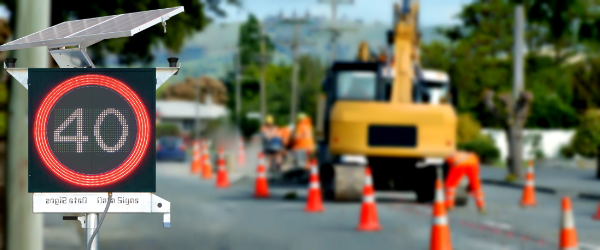
<a href="/Products/Variable-Speed-Limit-Signs" title="Variable Speed Limit Signs">Variable Speed Limit Signs (VSLS)</a>, also referred to as Electronic Speed Limit Signs (ESLS), are on the rise in SA, NSW, and QLD no longer allows traffic controllers to operate in traffic of over 1000 vehicles per day and a speed limit of 80 km/h or greater without portable traffic control devices. With the safety of road-users and site workers alike at the forefront of traffic management – it’s time for the rest of Australia to catch up.
<br /><br />
The remotely programmable electronic LED signs are a smart and safe way to enforce temporary speed limit changes in and around work sites, school zones or speed restricted areas compared to conventional static speed signs.
<br /><br />
VSLS boards allow for traffic controllers to remotely modify speed limits depending on the works being carried out or other situational factors. Traffic controllers can operate with the confidence that the speed displayed is enforceable by law. The ability to remotely and quickly change the display helps to improve worker safety and increases traffic efficiency as they can be easily adjusted outside of typical work hours.
<br /><br />
<b>Control what can be controlled</b>
<br /><br />
Being able to temporarily enforce a reduction in speed around worksites or road incidents can have multiple benefits. These include a significantly reduced risk of a safety hazard as it eliminates the need to manually change static speed signs in dangerous conditions, and as a result it also increases productivity hours on the work site.
<br /><br />
To comply with AS 5156:2010 Electronic speed limit signs, the display elements required on a VSLS are numerals that are illuminated in white with a red annulus on a matte black background.
<br /><br />
Mr Venema, CEO of traffic management equipment company, Data Signs, said a common issue with VSLS is the flaring effect on the display.
<br /><br />
“Flaring is a common problem where ambient light coupled with inappropriate light intensity obscures the visibility of an illuminated sign. This is where investing in VSLS boards that are compliant with Australian standards is a must, as the standard includes light sensors that will adjust the LED’s light output level based on the environmental ambient light levels.
<br /><br />
“As per the standard, the arrangement of LED’s on a VSLS should accommodate up to a 20 per cent failure in one numeral or the annulus without affecting recognisability. Any more than 20
per cent and your sign has failed.”
<br /><br />
<b>Ease and safety</b>
<br /><br />
Like any good equipment manufacturer, Data Signs is driven by safety and reliability.
<br /><br />
“At Data Signs, we recognise that the proper functioning of our traffic management equipment keeps people safe. Not just the people on work sites but road users and pedestrians. With this at the forefront of our production, we aim to produce high-quality, compliant equipment,” Mr Venema said.
<br /><br />
“The Data Signs VSLS for instance is compliant with AS 5156 and is programmable via our <a href="https://ds-live.com.au" target="_blank">DS-Live™</a> online platform or onsite via the onboard VSLS computer. This means that workers don’t need to expose themselves to dangerous conditions to manually change the displayed speed.”
<br /><br />
Data Signs VSLS boards are compliant with AS 5156 and have many other beneficial features including:
<br />
<ul>
<li>Full matrix LED display</li>
<li>Can display short safety instructions</li>
<li>Quick one-person setup</li>
<li>Retractable towbar for a smaller footprint and increased security</li>
<li>Extendable outriggers for greater stability</li>
<li>Forklift pockets for truck transport</li>
<li>Full electric mast with Mast Brake</li>
<li>Hot dipped galvanised chassis</li>
<li>Disc brake and override hand brake</li>
</ul>




